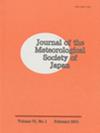基于长短期记忆网络的地面水平辐照度日内预报
IF 1.6
4区 地球科学
Q3 METEOROLOGY & ATMOSPHERIC SCIENCES
引用次数: 3
摘要
准确预测全球水平辐照度(GHI)是太阳能大面积渗透的电网管理的关键问题之一。太阳预报的一个挑战是预测1–8小时的太阳辐照度,这里称为日内预报。本研究研究了一种使用长短期记忆(LSTM)模型预测1-8小时内GHI的算法。LSTM模型以前曾用于日间(>24小时)太阳预报,但从未用于日内预报。科罗拉多州戈尔登的国家可再生能源实验室(NREL)进行了四年(2010-2013年)的观测,用于训练该模型。2014年在同一地点的观测结果用于测试模型性能。根据结果,在1–4小时的交付周期内,基于LSTM的模型可以预测GHI,均方根误差(RMSE)范围为77至143 W m,归一化均方根误差约为18.4–33.0%。在5分钟的输入下,LSTM相对于智能持久性模型的预测技巧为0.34–0.42,优于天气研究与预测(WRF)模型的随机森林预测(0.27)和数值天气预测(−0.40)。性能在4小时交付周期后趋于平稳。该模型在秋季和冬季比春季和夏季表现更好,在晴朗的天空条件下比在多云的条件下表现更好。使用来自再分析的相邻信息作为额外输入可以进一步提高预测性能。本文章由计算机程序翻译,如有差异,请以英文原文为准。
Intra-day Forecast of Ground Horizontal Irradiance Using Long Short-term Memory Network (LSTM)
Accurate forecast of global horizontal irradiance (GHI) is one of the key issues for power grid managements with large penetration of solar energy. A challenge for solar forecasting is to forecast the solar irradiance with a lead time of 1 – 8 hours, here termed as intra-day forecast. This study investigated an algorithm using a long short-term memory (LSTM) model to predict the GHI in 1 – 8 hours. The LSTM model has been applied before for inter-day (> 24 hours) solar forecast but never for the intra-day forecast. Four years (2010 – 2013) of observations by the National Renewable Energy Laboratory (NREL) at Golden, Colorado were used to train the model. Observations in 2014 at the same site were used to test the model performance. According to the results, for a 1 – 4 hour lead time, the LSTM-based model can make predictions of GHIs with root-mean-square-errors (RMSE) ranging from 77 to 143 W m, and normalized RMSEs around 18.4 – 33.0 %. With five-minute inputs, the forecast skill of LSTM with respect to smart persistence model is 0.34 – 0.42, better than random forest forecast (0.27) and the numerical weather forecast (−0.40) made by the Weather Research and Forecasting (WRF) model. The performance levels off beyond 4-hour lead time. The model performs better in fall and winter than in spring and summer, and better under clear-sky conditions than under cloudy conditions. Using adjacent information from the reanalysis as extra inputs can further improve the forecast performance.
求助全文
通过发布文献求助,成功后即可免费获取论文全文。
去求助
来源期刊
CiteScore
6.70
自引率
16.10%
发文量
56
审稿时长
3 months
期刊介绍:
JMSJ publishes Articles and Notes and Correspondence that report novel scientific discoveries or technical developments that advance understanding in meteorology and related sciences. The journal’s broad scope includes meteorological observations, modeling, data assimilation, analyses, global and regional climate research, satellite remote sensing, chemistry and transport, and dynamic meteorology including geophysical fluid dynamics. In particular, JMSJ welcomes papers related to Asian monsoons, climate and mesoscale models, and numerical weather forecasts. Insightful and well-structured original Review Articles that describe the advances and challenges in meteorology and related sciences are also welcome.

 求助内容:
求助内容: 应助结果提醒方式:
应助结果提醒方式:


